In general, anti-embolism stockings are for bedridden patients, while compression stockings are meant for everyone else with venous diseases or tired, swollen legs.
Many believe that anti-embolism stockings and compression stockings are interchangeable.
However, it is important to understand that these stockings are different, and each serve a different purpose. You can only achieve optimal results when the right one is used at the appropriate time.
Let’s talk Anti Embolism Stockings vs Compression Stockings …
What Are Anti-Embolism Stockings?

Anti-embolism stockings, or thromboembolic deterrent (TED) hose, are either knee- or thigh-high stockings made from elastane fabric.
These stockings apply pressure on the superficial veins by compressing the legs. In turn, this can reduce or prevent formation of blood clots and leads to an increase in blood flow, ensuring the veins do not expand.
In addition, anti-embolism stockings help prevent the adverse effects of venous distension during surgery.
They accomplish this through a graduated pressure pattern applied at the ankle, calf, popliteal, lower thigh and upper thigh. You will feel the compression of TED hose mainly in the ankle area.
Before using these stockings, the patient’s legs should be measured to ensure that the correct size is chosen to ensure the pressure pattern is appropriate. The right distribution of pressure will help prevent blood from pooling in both legs.
These white stockings are appropriate for patients who are either confined to a bed or just immobile.
Anti-embolism stockings will be ineffective for individuals who walk or stand.
Since TED stockings are not designed for mobility, nurses should choose compression socks rather than TED hose for wear during working hours.
These affordable TED stockings offer a temporary solution for post-surgery patients and patients in nursing homes. TED hose should be replaced with a new pair after about three weeks, as the socks will lose their effectiveness over time.
Who Uses Anti-Embolism Stockings?
Most often, surgical patients who have a high risk of venous thromboembolism (VTE) will wear anti-embolism stockings to prevent blood clots while bedridden.
Some of the other circumstances that may require a patient to use anti-embolism stockings include:

- Patients at high risk of having VTE, including those with active cancer, reduced mobility or a history of VTE.
- Patients who have impaired mobility (are bed bound or unable to walk without aid), even after being discharged from the hospital, can use TED stockings until they can walk unaided.
How to Wear Anti-Embolism Stockings
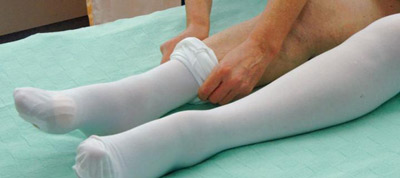
- First, measure each leg in order to get the correct size. This can be done in bed or in a standing position. Note that each leg may have different measurements.
- Before putting on your stockings, lie down and prop up your legs on top of pillows. Leave the legs on the pillows for about 15 minutes.
- To make it easier to wear the stockings, put some talc powder or cornstarch on each ankle. Your healthcare provider may also advise you on the type of powder you should use.
- Gently pull the stocking onto your foot. With short but quick movements, pull the loose material of the gathered stockings onto your leg.
- Smooth out any wrinkles to ensure compression will be properly applied across the legs.
What Are Compression Stockings?
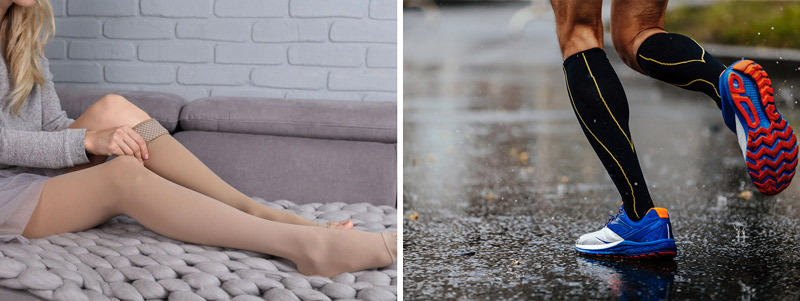
Compression stockings are an elastic hosiery worn to compress the legs. They are tight fitting, stretchy and can look like pantyhose or socks, depending on the fabric they are made from.
Strong elastane combined with nylon is used to increase pressure on the lower extremities such as the feet, ankles and legs.
Who Uses Compression Stockings?

Compression stockings are for anyone who is mobile enough to walk but is at risk of suffering from leg fatigue, lymphedema (leg swelling), varicose veins, etc. So many people can benefit from wearing compression sleeves:
- Athletes.
- Pregnant women who experience swelling.
- People whose work requires that they stand all day.
- Pilots and travellers who spend a lot of time on airplanes.
- People with low blood pressure and orthostatic hypotension.
How Do Compression Stockings Work?
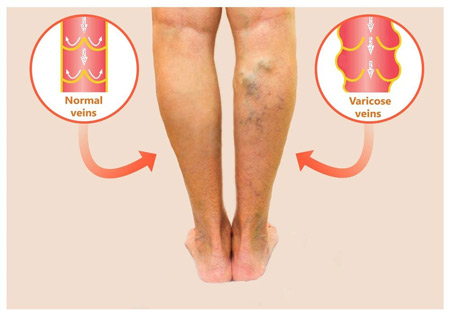
The main function of compression stockings is to help reduce the diameter of distended veins in the legs and to increase the velocity of venous blood flow. By so doing, the valves becomes more effective.
When the veins, arteries and muscles are compressed, blood will be forced to pass through narrower channels.
This increases pressure on the arteries, allowing a greater amount of blood to return to the heart and preventing blood from pooling in the feet.
Benefits of Compression Socks and Hosiery

Compression stockings act as extra support to the veins, boosting their ability to push blood to the heart. Let’s take a look at the benefits that come along with a good pair of compression socks:
- Less aching or swelling in the ankles and feet.
- Prevention of dizziness whenever you stand up.
- Guards against blood clots during extended periods of travel, such as on an airplane.
Medical Conditions that Require the Use of Compression Stockings
Some medical conditions that require a person to use compression stockings include:

- Chronic peripheral venous insufficiency: This condition occurs when the veins can no longer pump deoxygenated blood to the heart.
- Deep vein thrombosis: This condition occurs when blood flow in the lower extremities decreases, causing blood to pool in the legs and form blood clots.
- Edema:This condition occurs when opposing forces in small blood vessels as well as capillaries cause the plasma water to enter the soft tissues in a process known as net ultra-filtration.
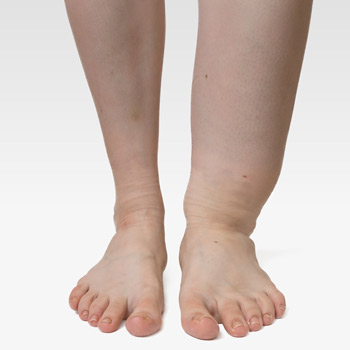
- Lipodermatosclerosis: This refers to a subcutaneous fat that is inflamed and is one of the ways panniculitis forms.
- Lymphedema: This medical condition has to do with the swelling of a body part where the lymph fluid is accumulating abnormally. It usually happens when something interferes with the process of lymph fluid drainage into the blood. Consequently, this could make the arm, neck, leg or abdomen swell.
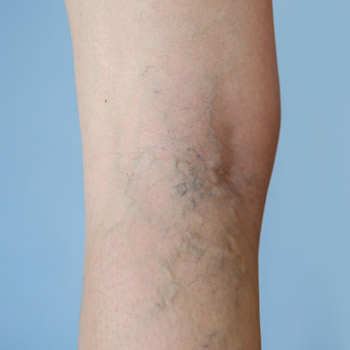
- Phlebitis: This occurs when the vein is inflamed and has blood clots in it caused by trauma, infection or inflammation. It is predominantly found in leg veins and mostly affects people with varicose veins. Due to the sudden occurrence of inflammation, the thrombus firmly adheres to the wall of the vein and blocks the superficial vein, which increases the riskiness of the blood clots.
- Varicose veins: These veins are saccular and distended with a tendency to expand, leading to venous inflammation. When they develop, they can be very painful and will not disappear without treatment. When varicose veins form externally, it is a sign that the patient has venous weakness.
How to Wear Compression Stockings
- First, measure your feet and legs in order to get the correct size.
It is best to do this in a standing position.
Often the sizing for compression socks will correspond with the sizing for your shoes.
If you have strong calves, you may need to opt for wide-calf compression socks. - Put your compression garments on first thing in the morning, before swelling occurs in the legs.
Alternatively, you can lie down and prop up your legs on top of pillows for about 15 minutes before donning your socks. - If you are struggling to pull your socks on over your feet, put some talc powder or cornstarch on each ankle. This can help ease the fabric over your skin, especially on hot days if you are sweating.
- Gently pull the stocking onto your foot. With short but quick movements, pull the loose material of the gathered stockings up your leg.
- Smooth out any wrinkles to ensure compression will be properly applied across the legs. The socks should lay flat against your legs without bunching.
- Do not roll down the tops of your compression sleeves because it may cut off circulation around the rolled fabric.
When the stockings are too tight, poor circulation can result–the opposite of what your compression socks are meant to do. - If your stockings were prescribed by a doctor, you should follow their personalized instructions. Often you will be advised to keep the compression sleeves on all day.
- You should take the compression stockings off when you want to bathe. It is possible to wear your regular socks, shoes or slippers over the compression socks otherwise and continue about your everyday activities.
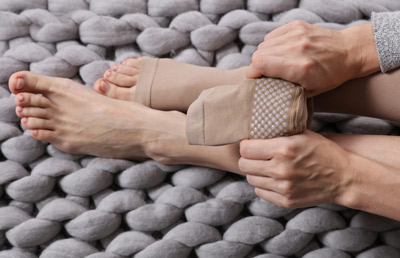
Anti-Embolism Stockings vs. Compression Stockings
Quite often, patients receive the wrong stockings for their condition. The differences between anti-embolism and compression stockings relate to their alternate uses.
Here are some of the major differences based on purpose, design, compression level and duration of wear:
Purpose:
Although both stockings apply pressure, it is important to note that they differ in their purpose. The medical reason behind wearing them is the best way to differentiate anti-embolism stockings from compression stockings.
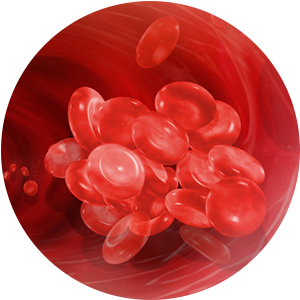
Anti-Embolism Socks: TED hose is worn to prevent blood pooling and to reduce the risk of blood clotting (embolism). That’s why anti-embolism stockings are best suited for post-operative patients or patients who are not mobile.

Compression Socks: In contrast, compression stockings focus on improving blood flow. They are designed to meet the needs of ambulatory (mobile) patients.
Compression stockings are highly recommended by physicians for treating conditions like edema, chronic venous insufficiency, varicose veins, deep vein thrombosis, lymphedema, phlebitis, lipodermatosclerosis and are even used during pregnancy to prevent swelling.
Design:
TED hose and compression stockings are designed differently in order to fulfill their specific goals.

Anti-Embolism Stockings: These are only found in white and have a small hole around the toes to allow for monitoring of the circulatory status of the patient.
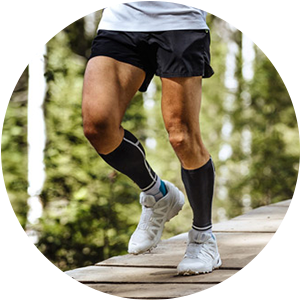
Compression Stockings: On the other hand, pressure socks and compression stockings come in a multitude of different styles and colors.
Compression Levels:
One key difference between anti-embolism stockings and compression stockings is that they vary in compression levels. Both stockings will have their compression levels measured in millimeters of mercury (mmHg).
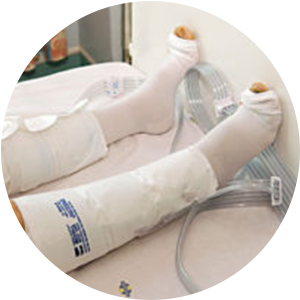
Anti-Embolism Stockings: Most anti-embolism stockings have a compression level of 8 to 18mmHg. This means that the compression level of anti-embolism stockings is lower than that of compression stockings.
Anti-embolism stockings also offer graduated compression. The stockings are very tight around the ankle but ease up gradually towards the knees.
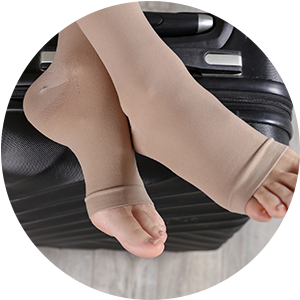
Compression Stockings: Compression stockings are mainly classified into three compression levels: 30 to 40mmHg, 20 to 30mmHg and 15 to 20mmHg.
It is important that patients who need compression levels that exceed 30mmHg get a doctor’s prescription first. Some compression stockings are graduated and some have a uniform application of pressure across the leg.
Duration:
The duration of use for each type of stocking will depend on the individual situation.

Anti-Embolism Stockings: Usually, anti-embolism stockings are used for short-term situations. They will have to be replaced with a new pair after about three weeks.

Compression Stockings: Compression socks are acceptable for long-term use. They will last for about 6 months before they will need to be replaced.
Final Thoughts
It is important to give your legs the right support when needed.
Medical personnel, patients and caregivers need to be aware of the differences between anti-embolism stockings and compression stockings. An in-depth understanding of the patient’s condition is also required before choosing the most suitable compression garments.
Remember that individuals should be assessed by health professionals, have their legs measured and then be closely monitored while using TED stockings.
Compression socks may be purchased over-the-counter and only require a prescription for higher pressure levels.
This page last updated November 5, 2022
